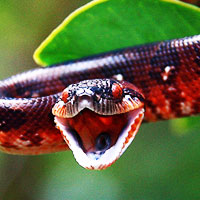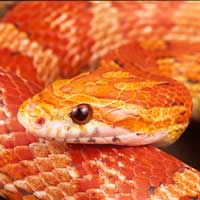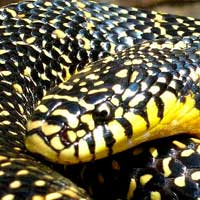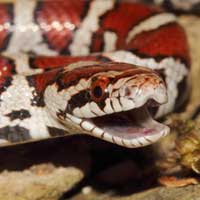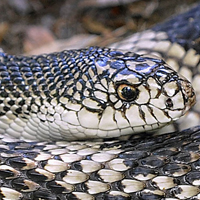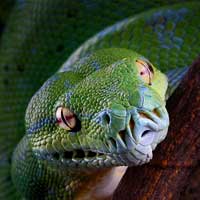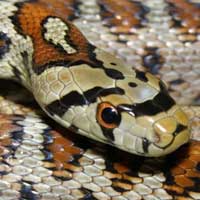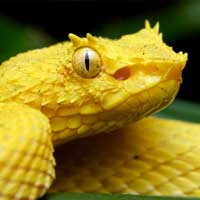Louisiana Milksnake: A Complete Care Guide
The Louisiana Milksnake is scientifically named Lampropeltis triangulum amaura. It belongs to the Colubridae family, which comprises a wide variety of non-venomous snakes.
Scientific Name: Lampropeltis triangulum amaura
Snake Family: Colubridae
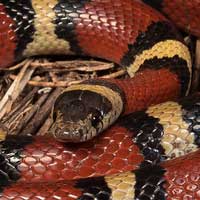
Louisiana Milksnake: An Overview
The Louisiana Milksnake (Lampropeltis triangulum amaura) is a vibrant and captivating subspecies of the milksnake family. Known for its striking red, black, and cream or yellow banding, this non-venomous snake is native to the southern United States. With its manageable size, docile temperament, and striking coloration, the Louisiana Milksnake is a favorite among reptile enthusiasts. Whether you’re new to snake keeping or a seasoned hobbyist, this guide will provide all the information you need to care for this remarkable species.
Where Does the Louisiana Milksnake Live?
The Louisiana Milksnake is native to the southern United States, particularly in regions with a warm climate. Its adaptability to various environments makes it a hardy species in captivity.
| Habitat Feature | Description |
|---|---|
| Geographic Range | Southern United States, including Louisiana |
| Preferred Environment | Forests, grasslands, and rocky areas |
| Climate | Warm, with moderate to high humidity |
What Does the Louisiana Milksnake Eat?
The Louisiana Milksnake is a carnivorous species, preying on small mammals, birds, reptiles, and amphibians in the wild. Replicating this diet in captivity ensures their health and longevity.
- Juveniles: Feed on pinky mice every 5-7 days.
- Adults: Feed on adult mice or small rats every 7-10 days.
- Prey Size: Ensure prey is no larger than 1.5 times the snake’s girth.
- Hydration: Provide fresh water daily for drinking and soaking.
Behavior and Temperament of the Louisiana Milksnake
The Louisiana Milksnake is known for its calm and curious nature, making it a favorite among snake enthusiasts. Its temperament is predictable, making it ideal for handling and observation.
- Shy Nature: Prefers hiding spots but becomes more confident with regular handling.
- Activity Level: Primarily nocturnal but may explore its enclosure during the day.
- Defensive Behavior: Rarely bites but may vibrate its tail or musk when startled.
How to Ensure a Healthy and Long Life for the Louisiana Milksnake
With proper care, the Louisiana Milksnake can live up to 20 years in captivity. Providing an optimal environment and monitoring for potential health issues are essential to their longevity.
| Health Issue | Symptoms | Prevention |
|---|---|---|
| Respiratory Infections | Wheezing, open-mouth breathing | Maintain proper humidity and temperature |
| Skin Shedding Issues | Incomplete or stuck sheds | Provide adequate humidity levels |
| Parasites | Visible mites, itching | Regular cleaning and enclosure maintenance |
Reproductive Traits of the Louisiana Milksnake
The Louisiana Milksnake is oviparous, laying eggs rather than giving birth to live young. Breeding this species requires careful planning and proper environmental conditions.
- Mating Season: Late spring to early summer.
- Incubation Period: Approximately 60-65 days.
- Clutch Size: Typically 6-12 eggs.
- Maintain an incubation temperature of 80-85°F for optimal egg development.
How to Handle and Care for the Louisiana Milksnake
Caring for the Louisiana Milksnake is relatively straightforward, making it an excellent choice for both beginners and experienced keepers. Proper handling and habitat maintenance ensure a stress-free and healthy snake.
- Provide an enclosure with a temperature gradient of 75-85°F.
- Use a substrate like aspen shavings or coconut fiber for burrowing.
- Include hiding spots, climbing branches, and enrichment items.
- Handle gently and regularly to build trust and reduce stress.
- Ensure the enclosure is cleaned frequently and provide fresh water daily.
